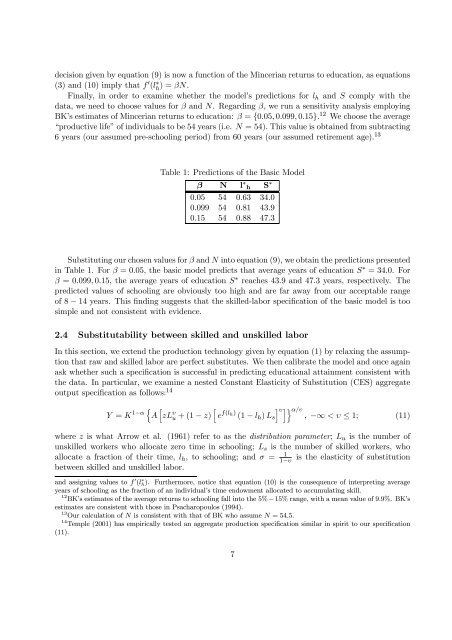MATCHING UP THE DATA ON EDUCATION WITH ... - Ivie
Create successful ePaper yourself
Turn your PDF publications into a flip-book with our unique Google optimized e-Paper software.
decision given by equation (9) is now a function of the Mincerian returns to education, as equations<br />
(3) and (10) imply that f (l ∗ h )=βN.<br />
Finally, in order to examine whether the model’s predictions for l h and S comply with the<br />
data, we need to choose values for β and N. Regarding β, we run a sensitivity analysis employing<br />
BK’s estimates of Mincerian returns to education: β = {0.05, 0.099, 0.15}. 12 We choose the average<br />
“productive life” of individuals to be 54 years (i.e. N = 54). This value is obtained from subtracting<br />
6 years (our assumed pre-schooling period) from 60 years (our assumed retirement age). 13<br />
Table 1: Predictions of the Basic Model<br />
β N l ∗ h S ∗<br />
0.05 54 0.63 34.0<br />
0.099 54 0.81 43.9<br />
0.15 54 0.88 47.3<br />
Substituting our chosen values for β and N into equation (9), we obtain the predictions presented<br />
in Table 1. For β =0.05, the basic model predicts that average years of education S ∗ =34.0. For<br />
β =0.099, 0.15, the average years of education S ∗ reaches 43.9 and47.3 years, respectively. The<br />
predicted values of schooling are obviously too high and are far away from our acceptable range<br />
of 8 − 14 years. This finding suggests that the skilled-labor specification of the basic model is too<br />
simple and not consistent with evidence.<br />
2.4 Substitutability between skilled and unskilled labor<br />
In this section, we extend the production technology given by equation (1) by relaxing the assumption<br />
that raw and skilled labor are perfect substitutes. We then calibrate the model and once again<br />
ask whether such a specification is successful in predicting educational attainment consistent with<br />
the data. In particular, we examine a nested Constant Elasticity of Substitution (CES) aggregate<br />
output specification as follows: 14<br />
<br />
<br />
υ α/υ<br />
Y = K 1−α A zL υ u +(1− z) e f(lh) (1 − l h ) L s , −∞ < υ ≤ 1; (11)<br />
where z is what Arrow et al. (1961) refer to as the distribution parameter; L u is the number of<br />
unskilled workers who allocate zero time in schooling; L s is the number of skilled workers, who<br />
allocate a fraction of their time, l h , to schooling; and σ = 1<br />
1−υ<br />
is the elasticity of substitution<br />
between skilled and unskilled labor.<br />
and assigning values to f (l ∗ h). Furthermore, notice that equation (10) is the consequence of interpreting average<br />
years of schooling as the fraction of an individual’s time endowment allocated to accumulating skill.<br />
12 BK’s estimates of the average returns to schooling fall into the 5% −15% range, with a mean value of 9.9%. BK’s<br />
estimates are consistent with those in Psacharopoulos (1994).<br />
13 Our calculation of N is consistent with that of BK who assume N =54.5.<br />
14 Temple (2001) has empirically tested an aggregate production specification similar in spirit to our specification<br />
(11).<br />
7

















